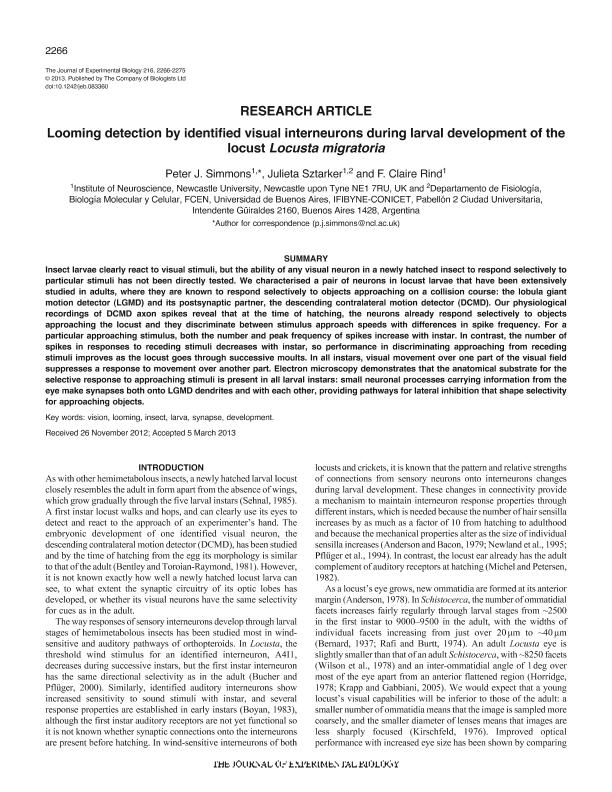Mostrar el registro sencillo del ítem
dc.contributor.author
Simmons, Peter J.
dc.contributor.author
Sztarker, Julieta

dc.contributor.author
Rind, F. Claire
dc.date.available
2017-07-11T19:12:06Z
dc.date.issued
2013-03
dc.identifier.citation
Simmons, Peter J.; Sztarker, Julieta; Rind, F. Claire; Looming detection by identified visual interneurons during larval development of the locust Locusta migratoria; Company of Biologists; Journal of Experimental Biology; 216; 3-2013; 2266-2275
dc.identifier.issn
0022-0949
dc.identifier.uri
http://hdl.handle.net/11336/20135
dc.description.abstract
Insect larvae clearly react to visual stimuli, but the ability of any visual neuron in a newly hatched insect to respond selectively to particular stimuli has not been directly tested. We characterised a pair of neurons in locust larvae that have been extensively studied in adults, where they are known to respond selectively to objects approaching on a collision course: the lobula giant motion detector (LGMD) and its postsynaptic partner, the descending contralateral motion detector (DCMD). Our physiological recordings of DCMD axon spikes reveal that at the time of hatching, the neurons already respond selectively to objects approaching the locust and they discriminate between stimulus approach speeds with differences in spike frequency. For a particular approaching stimulus, both the number and peak frequency of spikes increase with instar. In contrast, the number of spikes in responses to receding stimuli decreases with instar, so performance in discriminating approaching from receding stimuli improves as the locust goes through successive moults. In all instars, visual movement over one part of the visual field suppresses a response to movement over another part. Electron microscopy demonstrates that the anatomical substrate for the selective response to approaching stimuli is present in all larval instars: small neuronal processes carrying information from the eye make synapses both onto LGMD dendrites and with each other, providing pathways for lateral inhibition that shape selectivity for approaching objects.
dc.format
application/pdf
dc.language.iso
eng
dc.publisher
Company of Biologists

dc.rights
info:eu-repo/semantics/openAccess
dc.rights.uri
https://creativecommons.org/licenses/by-nc-sa/2.5/ar/
dc.subject
Looming
dc.subject
Development
dc.subject
Insect Larva
dc.subject
Synapse
dc.subject.classification
Otras Ciencias Biológicas

dc.subject.classification
Ciencias Biológicas

dc.subject.classification
CIENCIAS NATURALES Y EXACTAS

dc.title
Looming detection by identified visual interneurons during larval development of the locust Locusta migratoria
dc.type
info:eu-repo/semantics/article
dc.type
info:ar-repo/semantics/artículo
dc.type
info:eu-repo/semantics/publishedVersion
dc.date.updated
2017-07-11T13:21:32Z
dc.journal.volume
216
dc.journal.pagination
2266-2275
dc.journal.pais
Reino Unido

dc.journal.ciudad
Cambridge
dc.description.fil
Fil: Simmons, Peter J.. University of Newcastle; Reino Unido
dc.description.fil
Fil: Sztarker, Julieta. Consejo Nacional de Investigaciones Científicas y Técnicas. Oficina de Coordinación Administrativa Ciudad Universitaria. Instituto de Fisiología, Biología Molecular y Neurociencias. Universidad de Buenos Aires. Facultad de Ciencias Exactas y Naturales. Instituto de Fisiología, Biología Molecular y Neurociencias; Argentina
dc.description.fil
Fil: Rind, F. Claire. University of Newcastle; Reino Unido
dc.journal.title
Journal of Experimental Biology

dc.relation.alternativeid
info:eu-repo/semantics/altIdentifier/doi/http://dx.doi.org/10.1242/jeb.083360
dc.relation.alternativeid
info:eu-repo/semantics/altIdentifier/url/http://jeb.biologists.org/content/216/12/2266
Archivos asociados
